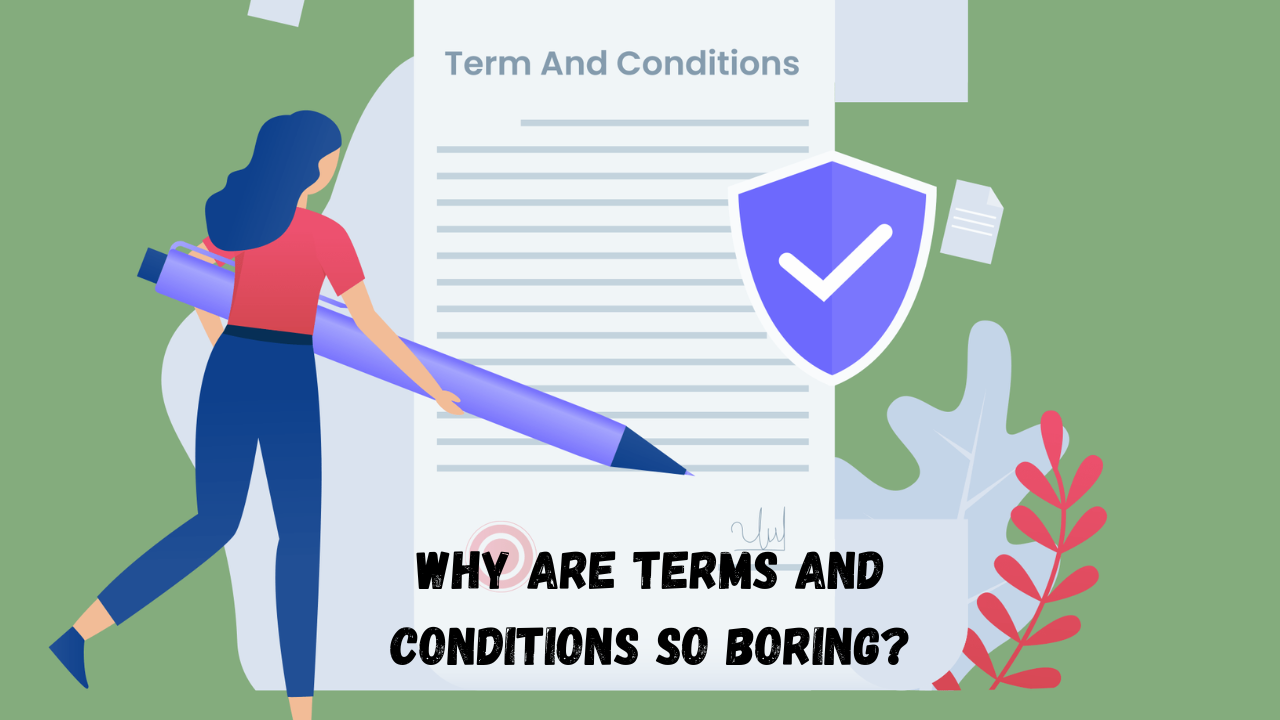Why Are Terms and Conditions So Boring?
 Aakashi Jaiswal
Aakashi Jaiswal
The lengthy and often tedious nature of terms and conditions (T&Cs) can be a source of frustration for many users. While they serve a vital purpose in protecting both the company and the consumer, their complexity raises questions about the psychology behind their design.
The Purpose of Terms and Conditions

-Legal Protection
At their core, T&Cs are legal documents that outline the rights and responsibilities of both parties involved in a transaction or service agreement. They protect companies from liability by clearly stating what is expected from users, including limitations on liability, dispute resolution processes, and user obligations.
This legal necessity often results in dense language filled with jargon that can be difficult for the average person to comprehend.
-Consumer Awareness
Another critical function of T&Cs is to inform consumers about their rights. Companies are legally required to disclose certain information, such as privacy policies, data usage, and cancellation rights. However, this obligation can lead to lengthy documents that prioritize legal compliance over user-friendliness.
The Psychology Behind Lengthy T&Cs
-Cognitive Overload
One reason T&Cs are often so long is due to cognitive overload. When faced with complex information, users may experience difficulty processing all the details. Research indicates that when people encounter overwhelming amounts of information, they tend to disengage rather than make informed decisions. This disengagement can lead to a lack of understanding about what they are agreeing to, which ironically contradicts the purpose of these documents.
-Desensitization
Many users have become desensitized to reading T&Cs due to their ubiquity in digital interactions. As a result, they may skim through or completely ignore these documents, leading to a false sense of security regarding their rights and obligations. This phenomenon is known as "terms fatigue," where users feel overwhelmed by the sheer volume of agreements they encounter online.
-Trust Issues
The length and complexity of T&Cs can also contribute to trust issues between consumers and companies. When users perceive T&Cs as unnecessarily complicated or lengthy, they may question the company's transparency and integrity. This skepticism can lead to negative perceptions of the brand, even if the terms themselves are fair.
Strategies for Improvement
-Simplifying Language
One way companies can improve user engagement with T&Cs is by simplifying the language used in these documents. By avoiding legal jargon and using clear, concise language, companies can make T&Cs more accessible to the average user. For example, instead of saying "indemnify," a company could say "you agree to protect us from any claims.
Another effective strategy is to provide a summary or key points section at the beginning of the document. This allows users to quickly grasp the most important aspects without wading through pages of text. Highlighting essential information such as data usage policies or cancellation procedures can help users feel more informed and empowered.
Interactive Formats
Adopting interactive formats for T&Cs could also enhance user engagement. For instance, companies could use checkboxes or quizzes that require users to acknowledge specific sections before proceeding. This approach not only ensures that users pay attention but also reinforces their understanding of critical terms.
The Role of Design
Visual Appeal
The design of T&Cs plays a significant role in user engagement. A visually appealing layout with headings, bullet points, and ample white space can make dense text more digestible. Companies should aim for a clean design that guides users through the document rather than overwhelming them with walls of text.
Mobile Optimization
With an increasing number of users accessing services via mobile devices, optimizing T&Cs for mobile viewing is essential. A responsive design that allows for easy scrolling and reading on smaller screens can significantly improve user experience.
The complexity and length of terms and conditions stem from legal requirements and the need for consumer protection. However, this necessity often results in documents that are tedious and difficult for users to engage with meaningfully. By understanding the psychological barriers that arise from cognitive overload and desensitization, companies can take steps to simplify their T&Cs.
Implementing strategies such as simplifying language, summarizing key points, adopting interactive formats, improving visual appeal, and optimizing for mobile devices can enhance user engagement while fulfilling legal obligations. Ultimately, making T&Cs more accessible not only benefits consumers but also fosters trust between companies and their customers. By addressing these issues head-on, we can transform what has traditionally been a boring chore into an informative experience that empowers users to make better-informed decisions about their agreements with businesses.
Subscribe to my newsletter
Read articles from Aakashi Jaiswal directly inside your inbox. Subscribe to the newsletter, and don't miss out.
Written by

Aakashi Jaiswal
Aakashi Jaiswal
Coder | Winter of Blockchain 2024❄️ | Web-Developer | App-Developer | UI/UX | DSA | GSSoc 2024| Freelancer | Building a Startup | Helping People learn Technology | Dancer | MERN stack developer